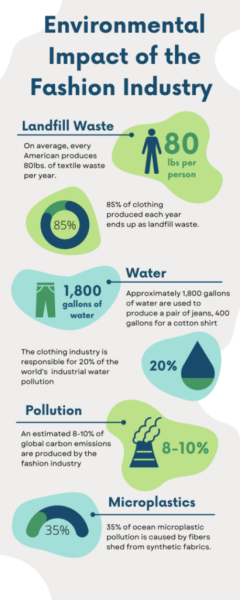In recent months, the fast fashion industry has come under increasing pressure for its environmental and social impacts, causing people to demand for accountability. As customers and consumers become more aware of the crisis and consequences of fast fashion, many brands face backlash yet nothing is being done. Should we buy our clothes from brands that use natural fabrics and that are more sustainable instead of buying everything that’s trending and then throwing it away in a few months?
Fast fashion retailers, known for producing inexpensive clothing at a rapid pace, have contributed significantly to the global waste crisis, says The Center for Biological Diversity, “Though both the fashion industry and consumers have indicated that sustainability is a priority, fast fashion is an increasingly unsustainable market that continues to grow, relatively unchecked…with the average number of each garment manufactured ranging from 50-100 dollars, according to the Shein website, this results in a minimum of 50,000 new garments created every day.” The rise of micro trends has increased the poor quality of clothes being mass-produced with no interest for the environment. They have not been held responsible for the dangers it causes to our environment.

The Center for Biological Diversity also realized the harmful effects stating, “The pollution introduced by the fast fashion industry results in devastating impacts to both terrestrial and aquatic environments, with harmful effects linked to habitat degradation, proliferation of chemicals and microplastics in waterways, and the increasing impact of climate change from anthropogenic greenhouse gas emissions.” In response to mounting pressure, several major retailers are beginning to adopt more sustainable practices. Brands like H&M and Zara have launched recycling initiatives and are committed to using organic materials in their collections. However, critics argue that these measures are insufficient and often serve as a marketing ploy rather than a genuine effort to change.
What we can do is a popular option to say the least, buy from 2nd hand retailers. The rise of secondhand shopping and thrift culture has emerged as a counter-trend to fast fashion. Platforms like Depop and Poshmark have gained popularity, with many consumers opting to buy pre-owned items instead of new ones. The Vanguard says that buying from 2nd hand shops means standing against overconsumption, “I turn to secondhand platforms such as Depop, eBay, Poshmark, and Etsy. Shopping secondhand means promoting a circular economy, standing against fast fashion, and being able to shop more sustainably. Nine times out of ten, this sustainable way of shopping will result in that one-of-a-kind gem that satisfies your retail fantasies.” Turning to other methods (besides thrifting) of shopping, to avoid fast fashion is not as accessible to everybody, now that thrifting is a trend in itself. The problem with this is that thrifting shops realize this and raise prices. When you walk into Goodwill, who do you think is most likely to be there? People come with an urge to thrift in order to find vintage pieces to resell on Depop. The impact here is reselling at a much higher price than intended. This can lead to a demand for certain styles of clothes, that could be found WHILE thrifting. This can also cause markups at local thrift stores in order to make more cash.
As the conversation around sustainability and accessibility continues to evolve, experts suggest that systemic changes are necessary. Policymakers are urged to implement stricter regulations on waste and emissions in the fashion industry, while consumers are encouraged to prioritize quality over quantity. As activists and consumers push for a more sustainable future, the industry may be forced to confront the harsh realities of its practices or risk losing a growing segment of environmentally conscious shoppers. As the tide turns, the question remains: will fast fashion adapt to survive, or will it eventually falter? Only the decisions of the consumers will tell.
Sources:







